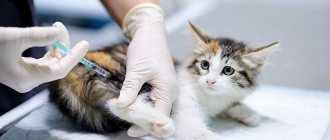The main danger of rabies is the lack of treatment and 100% mortality. Widespread vaccination of people against this serious disease is not carried out due to possible complications. However, timely administration of an anti-rabies vaccine after a bite of a cat or other animal helps prevent the development of symptoms of rabies in humans and ensures complete destruction of the virus in the body. Let's find out what symptoms indicate the presence of infection.
What is rabies
Rabies is an infectious disease of viral etiology that gradually affects the entire peripheral nervous system. A person becomes infected through contact with the saliva of an infected animal through injuries to the skin or mucous membranes.
Currently, there is no treatment for the disease, but it is possible to prevent the development of rabies symptoms in a person after a cat bite through timely vaccination. If the vaccine was not administered before the first clinical signs appeared, then death is inevitable.
The rabies virus is a neurotropic microorganism whose size ranges from 100 to 150 nm. Bullet-shaped virions gradually penetrate the cerebral cortex through ascending neurons, then descend into the salivary glands and are released into the external environment.
In the cytoplasm of the affected brain cells, during the life of the pathogen, specific inclusions are formed - Babes-Negri bodies. Their detection plays a leading role in the post-mortem diagnosis of the disease in cats and other animals.
The rabies virus as it is
The rabies virus (in Latin Rabies virus) is very insidious and easily passes into the human body from the saliva of affected animals - for this it only needs damage to the skin, inevitably received by a person through a bite or for some reason previously.
The virus multiplies in nervous tissue and migrates along nerve pathways from the site of infection to the brain at a speed of about 3 mm per hour. Therefore, particularly dangerous places for bites are the hands and head, from where the virus can very quickly penetrate the brain. Having reached the spinal cord and brain, it causes severe inflammation with the death of tissue areas.
Photo of rabies virus
Routes of transmission
The natural reservoir of rabies is wild animals (foxes, wolves, wild boars, badgers). But in humans, symptoms of the disease most often appear from a cat or dog bite.
The virus begins to be excreted in the saliva of an infected cat 3-10 days before clinical signs appear. This continues throughout the entire period of the disease, until the death of the animal. Therefore, a person is at risk of contracting rabies not only through a bite, but also through contact with fur that has been exposed to the saliva of an infected cat.
Very important! The rabies virus persists in the animal's corpse for several weeks after death. Therefore, it is necessary to completely eliminate contact with the cat’s body, surrounding objects and surfaces, after which you should call the veterinary service or the Ministry of Emergency Situations.
In medical practice, isolated cases of human infection from bat bites have been recorded. But those most at risk are hunters who come into contact with killed wild animals, do not follow safety precautions, and do not send them to a veterinary laboratory for examination. They can also be bitten by a wounded animal.
In small rodents, a protracted latent phase of rabies or virus carriage is often observed. At the same time, cats can become infected from them during hunting. But cases of human infection from rats and mice are extremely rare.
When cat bites are a real threat
If a person is bitten by a cat on the street, the risk of contracting rabies and tetanus can be very high. Stray animals live in unsuitable conditions, most often in the basements of houses, where they have to share the same territory with rats.
These unattractive creatures are one of the main carriers of infection and spreaders of dangerous diseases. They can be rabid, and the rat's bite infects the cat, which can then scratch or bite a person.
In rural areas, wild animals often become the source of rabies, but your own domestic cat, which has free range and contact with other cats and inhabitants of forests and fields, can become a source of infection. If she is bitten by a fox, hedgehog, raccoon or any other wild animal with rabies, yesterday's pet will become a mortal threat to many people. Children who love to play with kittens are especially at risk.
The peak incidence is spring and summer, when the rabies virus multiplies massively. During this period, the risk of infection is greatest.
Although it is believed that the disease does not occur very often, it is fatal, since it is useless to treat an animal or person with already manifested clinical symptoms - they are doomed to a painful death. You can only help if you vaccinate the patient within a very short time after the bite. This is the only action at the moment that can resist the disease.
Main signs of rabies in cats
The latent period of rabies, during which domestic cats do not show clinical symptoms, lasts from 9 days to 2 months. For pets that grew up in the wild, it can last 6 months or more.
The duration of the latent phase of the disease depends on the following factors:
- bite site;
- the amount of pathogen entering the wound;
- depth of damaged tissue;
- the state of the cat’s immune system at the time of infection.
Further, rabies in cats can occur in three forms:
- classical;
- "quiet";
- atypical.
Symptoms of the classic form of feline rabies depend on the period of the disease.
| Period name | Duration | Clinical signs |
| Prodromal period | 1-2 days | A radical change in behavior (affectionate pets begin to show aggression, and evil cats become kind and intrusive), the desire to hide in a dark place, depression, avoidance of contact with the owner and other pets, swallowing inedible objects |
| Excitation period | 2-4 days | Irritability, excessive aggressiveness, muscle tremors, lack of coordination of movements, spasm of the laryngeal muscles, excessive constant salivation, discharge of foamy fluid from the mouth, gnawing on one’s own body |
| Paralysis or "silent phase" | 1 day | Uncoordinated work of the body muscles, convulsions, paralysis and death |
Important! In the fulminant form of rabies, symptoms of the excitation phase may be absent. Minor changes in behavior are abruptly replaced by convulsions, coma and death.
The initial stage of the silent form of rabies in cats is characterized by the following symptoms:
- apathy;
- complete lack of interest in surrounding objects;
- complete refusal of cat food due to the inability to swallow it;
- strabismus;
- asymmetrical change in the radius of the pupils;
- copious salivation.
After 2-3 days, paralysis and death occur.
The atypical form of rabies in cats is manifested by signs that are not characteristic of this disease. Over the course of several months (up to a year), the animal may experience:
- diarrhea followed by constipation and flatulence;
- apathy;
- convulsions;
- paralysis.
Next comes the stage of remission with bouts of relapses. Each subsequent relapse has more pronounced and severe symptoms.
Important! With an atypical form of rabies, when the main symptoms of infection in cats are absent, human infection can occur unnoticed.
Diagnosis of cat scratch disease
- Serological analysis or PCR testing;
- Sometimes a lymph node biopsy.
Diagnosis of cat bite disease is usually confirmed by positive serum Ab titers, or PCR testing of samples from lymph nodes.
Because enlarged lymph nodes can be caused by other infections (eg, tularemia, mycobacterial infection, brucellosis, fungal infection, lymphogranulomatosis venereum), testing may be done if the diagnosis is unclear and the cat does not have the disease.
A lymph node biopsy may be done if cancer is suspected or if the diagnosis of cat bite disease needs to be confirmed.
Incubation period for rabies in humans
The incubation period, when the first signs of rabies have not yet appeared in a person after a cat bite, averages from 1 to 2 months. However, this period can vary significantly depending on the location of the bite and the number of viruses that entered the wound.
A rabid cat can bite a person very hard. If she bites the face, head area or neck, then the latent phase is reduced to 7-10 days. But cases have been reported where 12 or more months pass from the moment of infection to the appearance of clinical symptoms. This is possible if the penetration of a small number of pathogens occurs in the area of a person’s arm or leg.
Consequences
Cat bites can be dangerous to both other animals and humans. Cats carry large amounts of bacteria in their mouths that can cause tissue infections. One of the most common is the highly pathogenic bacterium known as Pasteurella multocida, which is commonly found in cats' nasal cavity, oral cavity and tonsils.
An infected cat bite will appear as a red sore that is swollen and painful, and the infection can spread through surrounding tissue, causing a condition called cellulitis, or through the blood to other areas of the body, causing sepsis (blood poisoning).
Infected people may suffer from fever and flu-like symptoms sometimes, and may die when proper medical care is not given. Children, the elderly, the sick, or those with weakened immune systems are especially vulnerable to developing serious infections.
The picture shows an injury on the hand, which later became infected. This man tried to play with the cat with his bare hands. (Do not use your hands to play!)
Common characteristics associated with a cat bite include:
- Puncture type wound;
- a cut or tear in the skin with bleeding;
- Bruises around the site of the incision or puncture wound;
- Inflammation around the area of injury;
- Pain around the area;
- The skin around the injury is hot, a red border appears;
- Swelling and pus from the wound.
Signs of rabies in humans after a cat bite
After a cat bite, a person may develop violent and paralytic forms of rabies, which differ in signs of infection.
Violent form
Experts distinguish 3 stages of violent rabies in humans.
The initial (depressive) stage of the disease is characterized by the following clinical signs:
- burning, itching, increased sensitivity of the skin, nagging pain in the area of the wound or already formed scar;
- redness or inflammation of the scar;
- low-grade fever;
- apathy;
- sleep disturbance;
- decreased appetite;
- feeling of dryness in the mouth;
- increased anxiety, unreasonable fears;
- sudden mood swings;
- headaches and muscle pain.
Note! If the virus enters the human body through wounds on the face, then already at the first stage of rabies, hallucinations and other symptoms of mental disorders appear.
The depressive stage lasts from 1 to 3 days. By the end of the third day, apathy is gradually replaced by bouts of causeless irritability. A person experiences a feeling of chest compression, increased heart rate and respiratory movements without physical exertion.
The second stage (excitement) is characterized by the classic symptoms that manifest rabies after a person has been bitten by an infected cat:
- Rabies. This symptom is caused by a very painful spasm of the swallowing muscles. Against the background of mental disorders and an increase in the intensity of the pain syndrome, any reminder of water causes a strong contraction of the muscles of the pharynx, which complicates the breathing process. A person instinctively tries to avoid both direct and visual contact with any type of liquid, since he sees external factors as a source of suffering,
- Photo-, aero- and acoustic phobia are explained by increased sensitivity and heightened reaction to external stimuli.
- A frozen gaze, when a person looks at one point for a long time with bulging eyes. Damage to the nerves provokes severe dilation of the pupils and exophthalmos, in which the eyes protrude from their sockets.
- Hypersalivation caused by damage to the salivary glands.
The most striking symptom in a person after being bitten by a rabid cat is an attack of uncontrollable aggression. It is caused by violent psychomotor agitation, which is accompanied by frightening hallucinations.
At such moments, a person throws himself at living and inanimate objects, bites, tears clothes, spits, and harms himself and others. During the period between such attacks, consciousness clears, when the patient can adequately reason and assess the situation. But soon the attacks are repeated with renewed vigor.
Important! At the peak of a rabies attack, death may occur from cardiac arrest or paralysis of the respiratory center.
The duration of the excitation stage lasts no more than 2-3 days.
The third stage, which is characterized by the development of paralysis, is caused by extensive damage to the cortex and subcortical formations of the brain. Manifestations of this stage of rabies in humans after a cat bite are the following symptoms:
- convulsions;
- stopping attacks of hydrophobia;
- absence of attacks of aggression;
- increase in temperature to 41-42°C;
- pressure decreases to the minimum permissible values;
- tachycardia increases.
Muscular paralysis quickly spreads from the site of the bite and covers the entire body within 10-15 hours. Then a coma sets in and the person dies from paralysis of the respiratory center or heart muscles.
Paralytic form
With this form of rabies, the bitten person has no symptoms of apathy or agitation. A long latent period is followed by the appearance of paralysis, coma and death.
Important! In children, the incubation period for rabies is usually less than 7 days. After this, symptoms such as drowsiness, apathy, convulsions, paralysis, coma and death occur. The clinical stage lasts 1 day.
Clinical picture
The reaction to a cat bite depends on the location, depth, and area of the skin affected. It is important whether the cat was sick and vaccinated and what microorganisms are present in its saliva, since the bite itself is often not dangerous.
At best, a cat attack is accompanied only by painful sensations. If the skin is severely damaged, bleeding may occur. If an infection has entered the wound, the following symptoms appear:
- nausea;
- hyperemia of the skin at the site of the bite;
- the appearance of edema;
- temperature increase;
- development of purulent processes.
Bites on the hands are often infected
When infected with cat scratch disease, the following symptoms occur 3 weeks after the bite:
- chills;
- temperature increase to 38–40o C;
- loss of appetite;
- enlargement of lymph nodes located near the bite site;
- headache and poor health.
After approximately 2 weeks of illness, the patient's condition improves and the patient is on the mend. However, there are known cases of complications, resulting in the need for surgery to remove abscesses due to inflammation of the lymph node. Therefore, at the first signs of infection, consultation with a doctor is mandatory.
Bites from street cats are especially dangerous, leading to the development of clostridial infections (these include tetanus, gas gangrene and wound botulism).
The danger of being bitten by street cats is that they have multiple accumulations of pathogenic microorganisms on their fangs, which, when bitten, enter the human body
In this case, the following symptoms of the disease develop:
- the appearance of pus or lumps at the site of the bite;
- nausea and vomiting;
- loss of consciousness;
- temperature increase;
- the appearance of cramps in the arms and legs;
- tremor of the limbs.
If serious signs of complications appear, you should immediately call an ambulance. In some people, a cat bite can lead to the development of an immediate allergic reaction in the form of anaphylactic shock, which requires immediate medical intervention.
In a person who has been bitten by an animal with rabies, signs of infection appear after 1–3 weeks. The incubation period of the disease depends on the distance from the bite site to the head and can last up to 12 months. The first symptoms of the disease are:
- acute reaction to light - photophobia;
- intolerance to loud sounds and noise;
- inability to swallow or difficulty trying to drink water.
If such signs of irritation of the nervous system appear, the possibility of a cure for rabies is zero. The disease leads to muscle paralysis and, as a result, death.
Prevention of the development of rabies after the bite of a sick animal
Every person needs to clearly know what to do if he is bitten by a rabid cat.
To prevent the virus from entering the human body after a cat bite, the following algorithm of actions should be followed:
- wound treatment;
- conducting a course of active immunization with rabies vaccine;
- carrying out passive immunization by administering rabies immunoglobulin.
Note! In addition to helping a person after being bitten by a rabid cat, you need to know what to do next with the bitten animal. If your pet is a pet, you should check whether it is vaccinated against rabies. This way, the affected person will be able to avoid active immunization. In case of bites committed by stray cats, you should immediately consult a doctor, and also report the incident to the local authorities of the State Sanitary and Epidemiological Supervision and Veterinary Medicine.
Local wound treatment
You can minimize the risk of contracting rabies from a cat and avoid the manifestation of symptoms of the disease if you properly and quickly treat the site of a bite or scratch. To do this, you must follow the following rules:
- All areas of contact with cat saliva are washed with laundry or medical soap, followed by rinsing with plenty of running water.
- Treat the surface of the washed wound with a 3% solution of hydrogen peroxide.
- Treatment of healthy skin at the wound border with a 5% alcohol solution of iodine or brilliant green.
- Application of a pressure antiseptic bandage made of hygroscopic materials.
The doctor individually decides on the advisability of local antimicrobial treatment. Next, the victim of a cat bite is sent to a trauma center or the nearest medical facility for further professional assistance.
Important! After a person has been bitten by a rabid cat, it is prohibited to cauterize the wound, excise its edges, or apply stitches.
Immunoglobulin therapy
Passive immunization with immunoglobulin is carried out once during the first day after a cat bite. In extreme cases, intramuscular injection of the drug is allowed before the third dose of rabies vaccine is administered.
With timely treatment, half the dose of human immunoglobulin is used to puncture the wound, and the rest is injected into the muscle of the front of the thigh or delta of the shoulder.
This preventive measure is required if:
- deep wounds;
- multiple bites;
- localization of bites and other injuries in the head, neck, large lymph nodes, and hands.
Vaccination
Immediate vaccination is given to all patients who have been bitten or scratched by sick or suspected infected cats. If rabies is not confirmed in the animal within 10 days, then vaccination is stopped.
Modern rabies vaccines are administered 6 times over 90 days (with a certain interval). If a person has completed the full course of vaccination before the bite, then he is vaccinated twice - on the first and third days after potential infection.
The effectiveness of the rabies vaccine when administered within the first two weeks after contact with the saliva of an infected cat ranges from 96 to 98%. This figure decreases if vaccination is carried out at a later date.
Immunity to rabies in humans occurs 14 days after the last dose of the vaccine is administered. Its duration thereafter is 1 year.
Factors that reduce the effectiveness of vaccination include:
- drinking alcohol;
- intense physical activity;
- overheating or hypothermia of the body;
- taking corticosteroid drugs or immunosuppressants.
Important! If it is impossible to stop using corticosteroids and immunosuppressants during the course of rabies vaccination, then after its completion it is necessary to determine the level of antibodies to the rabies virus. Their absence serves as an indication for a second course of vaccinations.
Prevention
- Teach children not to tease pets;
- Be careful around unfamiliar cats;
- Approach an animal carefully, even if it seems friendly;
- Avoid rough play with kittens.
Rough play is perceived as aggressive. This will cause the cat to become defensive when people approach. Preventing cat bites means not provoking it. Handle your pet carefully, trying not to cause fear or aggression. A cat may bite its owner or someone nearby to protect itself.
How to protect yourself from infection if bitten by a cat
The risk of contracting rabies from the bite of a sick cat can be minimized by pre-exposure immunization. It is recommended for people who are at risk:
- work in disadvantaged areas;
- tourists who prefer outdoor recreation;
- animal shelter workers;
- workers of medical and veterinary laboratories who may come into contact with live rabies virus;
- researchers who have contact with wild animals or bats.
Some countries provide pre-exposure immunization to children who live in areas affected by rabies.
Such vaccination is not widespread, as it is an expensive method and can cause side effects that negatively affect human health. Therefore, when prescribing this type of rabies prevention, an objective assessment of the risk of infection is carried out, taking into account the complications that the administration of the vaccine may cause.
In what cases should you consult a doctor?
Not all bites require immediate medical attention, but in some cases it is necessary to visit the hospital as soon as possible:
- High temperature (over 38 degrees).
- Severe pain in the bite area and swelling.
- Bites inflicted on the neck or face.
- Bleeding from wounds that does not stop within 7-10 minutes.
- Inflammation in the affected area.
- Bites inflicted by stray or unvaccinated animals.
After inflicting wounds, you must go to the hospital within 10 hours.
About rabies vaccinations
In our country, as in most civilized countries of the world, vaccination against rabies is mandatory to prevent the disease in a domestic animal. A pet without vaccination will not be allowed to leave the country (restrictions will also be imposed when transporting by public transport), and it will not be able to participate in exhibitions. But despite this, we still have outbreaks of rabies among our four-legged pets. Even the fact that, according to a number of programs, vaccination against rabies is free of charge (in state veterinary clinics or special vaccination points) does not help.











